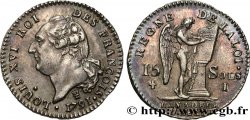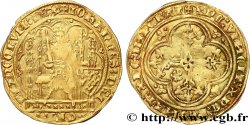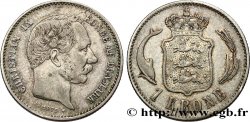bpv_296491 - CALÍGULA y AGRIPPINA MADRE Tétradrachme syro-phénicien
No disponible.
Artículo vendido en nuestra tienda (2014)
Precio : 1 800.00 €
Artículo vendido en nuestra tienda (2014)
Precio : 1 800.00 €
Tipo : Tétradrachme syro-phénicien
Fecha: 37
Nombre del taller / ciudad: Antioche, Syrie, Séleucie et Piérie
Metal: plata
Diámetro: 25 mm
Eje de acuñación: 12 h.
Peso: 14,58 g.
Grado de rareza: R3
Comentarios sobre el estado de conservación:
À noter une cassure de coin au droit que l’on retrouve avec une amplitude proche sur l’autre exemplaire certain
N° en los catálogos de referencia :
Pedigrí:
Cet exemplaire est le 0063A_002 de la base TSP. Il provient de la Collection Marcel Burstein , vente Peus 366, 25 10 2000, lot 1091
Anverso
Descripción del anverso: Tête laurée de Gaius Caligula à droite.
Leyenda del anverso: GAIOU KAISAROS SEBA GERMA
Traducción del anverso: Gaius César Auguste Germanique.
Reverso
Descripción del reverso: Buste drapé d’Agrippine mère à droite, dans le champ à droite A sur ET (ETOYC A = an 1 du règne) pas de point dans le champ gauche.
Leyenda del reverso: AGRIPPEINHS ANTIO MHTRO
Traducción del reverso: Agrippine Antioche Métropole.
Comentario
Cette variante sans point pour la première année du règne est signalée dans le Supplément du RPC sous le numéro 4164.
On ignore la signification de ce point mais il est certain qu’il en a une puisque le cas d’un point pour distinguer certaines émissions va se poursuivre jusqu’à Néron.
On ignore pourquoi l’Empereur fit le choix d’un revers illustrant sa mère mais il n’est pas impossible que ce choix local soit fondé sur l’impact qu’elle aurait pu avoir en Orient comme épouse de Germanicus.
Caligula est le fils de Germanicus et d’Agrippine mère. Il connaît bien l’Orient, puisque c’est là que son père va mourir empoisonné à trente-trois ans et qu’il va assister, lui-même âgé de sept ans, à la crémation de la dépouille. Il rapportera les cendres à Rome avec sa mère ; le Peuple et le Sénat joindront leurs lamentations à celles de la famille lorsque les cendres seront déposées dans le mausolée d’Auguste.
Si Germanicus fut un modèle de romain, son fils ne partageait malheureusement pas ses qualités ; son assassinat par les prétoriens en janvier 41, après qu’il eut succédé à Tibère et régné dans les débordements les plus extrêmes, fut un soulagement.
Peu d’événements marquants pour l’histoire romaine à l’est de l’Empire sauf à propos des relations avec les Juifs.
Philon d’Alexandrie raconte que durant l’hiver 39, un groupe de juifs fanatiques détruisit un autel païen dans un temple grec.
En représailles, Caligula décida qu’une statue de lui-même incarnant Zeus serait dressée dans le Temple de Jérusalem.
Il déclencha alors une révolte qui fut sévèrement réprimée. On ignore ce qu’il advint de la statue.
En revanche, il fut indirectement la cause de l’un des pires massacres de Juifs de l’Antiquité lorsque, en 37, des bandes de Grecs d’Alexandrie, avec la complicité du préfet d’Égypte A. Avilius Flaccus, assassinèrent pour les voler de nombreux Juifs de la ville. Les Juifs vivaient à Alexandrie depuis sa fondation, arrivés avec l’armée grecque d’Alexandre et de Ptolémée et ils avaient construit le seul ghetto du monde romain, de part leur propre volonté et non pas parce que les Grecs souhaitaient les confiner. En 38, Flaccus, fut jugé, condamné et exilé.
Dans un registre moins politique, Caligula aida le peuple d’Antioche après le tragique tremblement de terre du 9 avril 37 durant lequel la ville et le faubourg de Daphné furent gravement endommagés.
Dans la base TSP maintenue par Michel Prieur, trois exemplaires, aucun en musées ou en collections publiques, sont maintenant répertoriés. Le troisième exemplaire en plus du nôtre et de celui cité dans le RPC n’est pas certain, présenté très encrassé avec une mauvaise photo sur le grand site d’enchères.
This variant without a point for the first year of the reign is reported in the Supplement to the RPC under number 4164.
The significance of this point is unknown, but it is certain that it has one, since the use of a point to distinguish certain emissions will continue until Nero..
It is not known why the Emperor chose a reverse depicting his mother, but it is not impossible that this local choice was based on the impact she could have had in the East as the wife of Germanicus..
Caligula is the son of Germanicus and Agrippina the mother. He knows the Orient well, since it is there that his father will die poisoned at the age of thirty-three and he will attend, himself aged seven, the cremation of the remains.. He will bring the ashes back to Rome with his mother; the People and the Senate will join their lamentations to those of the family when the ashes are placed in the mausoleum of Augustus.
If Germanicus was a model Roman, his son unfortunately did not share his qualities; his assassination by the Praetorians in January 41, after he had succeeded Tiberius and reigned in the most extreme excesses, was a relief.
Few significant events in Roman history in the east of the Empire except for relations with the Jews.
Philo of Alexandria relates that in the winter of 39, a group of fanatical Jews destroyed a pagan altar in a Greek temple..
In retaliation, Caligula decided that a statue of himself embodying Zeus would be erected in the Temple of Jerusalem.
He then started a revolt which was severely repressed. It is unknown what happened to the statue..
On the other hand, he was indirectly the cause of one of the worst massacres of Jews in Antiquity when, in 37, bands of Greeks from Alexandria, with the complicity of the prefect of Egypt A. Avilius Flaccus, murdered many of the city's Jews for the sake of stealing them. Jews had lived in Alexandria since its founding, having arrived with the Greek army of Alexander and Ptolemy, and they had built the only ghetto in the Roman world, of their own free will and not because the Greeks wished to confine them.. In 38, Flaccus was tried, condemned and exiled.
On a less political note, Caligula helped the people of Antioch after the tragic earthquake of April 9, 37, during which the city and the suburb of Daphne were seriously damaged..
In the TSP database maintained by Michel Prieur, three examples, none in museums or public collections, are now listed.. The third example in addition to ours and the one mentioned in the RPC is not certain, presented very dirty with a bad photo on the large auction site
On ignore la signification de ce point mais il est certain qu’il en a une puisque le cas d’un point pour distinguer certaines émissions va se poursuivre jusqu’à Néron.
On ignore pourquoi l’Empereur fit le choix d’un revers illustrant sa mère mais il n’est pas impossible que ce choix local soit fondé sur l’impact qu’elle aurait pu avoir en Orient comme épouse de Germanicus.
Caligula est le fils de Germanicus et d’Agrippine mère. Il connaît bien l’Orient, puisque c’est là que son père va mourir empoisonné à trente-trois ans et qu’il va assister, lui-même âgé de sept ans, à la crémation de la dépouille. Il rapportera les cendres à Rome avec sa mère ; le Peuple et le Sénat joindront leurs lamentations à celles de la famille lorsque les cendres seront déposées dans le mausolée d’Auguste.
Si Germanicus fut un modèle de romain, son fils ne partageait malheureusement pas ses qualités ; son assassinat par les prétoriens en janvier 41, après qu’il eut succédé à Tibère et régné dans les débordements les plus extrêmes, fut un soulagement.
Peu d’événements marquants pour l’histoire romaine à l’est de l’Empire sauf à propos des relations avec les Juifs.
Philon d’Alexandrie raconte que durant l’hiver 39, un groupe de juifs fanatiques détruisit un autel païen dans un temple grec.
En représailles, Caligula décida qu’une statue de lui-même incarnant Zeus serait dressée dans le Temple de Jérusalem.
Il déclencha alors une révolte qui fut sévèrement réprimée. On ignore ce qu’il advint de la statue.
En revanche, il fut indirectement la cause de l’un des pires massacres de Juifs de l’Antiquité lorsque, en 37, des bandes de Grecs d’Alexandrie, avec la complicité du préfet d’Égypte A. Avilius Flaccus, assassinèrent pour les voler de nombreux Juifs de la ville. Les Juifs vivaient à Alexandrie depuis sa fondation, arrivés avec l’armée grecque d’Alexandre et de Ptolémée et ils avaient construit le seul ghetto du monde romain, de part leur propre volonté et non pas parce que les Grecs souhaitaient les confiner. En 38, Flaccus, fut jugé, condamné et exilé.
Dans un registre moins politique, Caligula aida le peuple d’Antioche après le tragique tremblement de terre du 9 avril 37 durant lequel la ville et le faubourg de Daphné furent gravement endommagés.
Dans la base TSP maintenue par Michel Prieur, trois exemplaires, aucun en musées ou en collections publiques, sont maintenant répertoriés. Le troisième exemplaire en plus du nôtre et de celui cité dans le RPC n’est pas certain, présenté très encrassé avec une mauvaise photo sur le grand site d’enchères.
This variant without a point for the first year of the reign is reported in the Supplement to the RPC under number 4164.
The significance of this point is unknown, but it is certain that it has one, since the use of a point to distinguish certain emissions will continue until Nero..
It is not known why the Emperor chose a reverse depicting his mother, but it is not impossible that this local choice was based on the impact she could have had in the East as the wife of Germanicus..
Caligula is the son of Germanicus and Agrippina the mother. He knows the Orient well, since it is there that his father will die poisoned at the age of thirty-three and he will attend, himself aged seven, the cremation of the remains.. He will bring the ashes back to Rome with his mother; the People and the Senate will join their lamentations to those of the family when the ashes are placed in the mausoleum of Augustus.
If Germanicus was a model Roman, his son unfortunately did not share his qualities; his assassination by the Praetorians in January 41, after he had succeeded Tiberius and reigned in the most extreme excesses, was a relief.
Few significant events in Roman history in the east of the Empire except for relations with the Jews.
Philo of Alexandria relates that in the winter of 39, a group of fanatical Jews destroyed a pagan altar in a Greek temple..
In retaliation, Caligula decided that a statue of himself embodying Zeus would be erected in the Temple of Jerusalem.
He then started a revolt which was severely repressed. It is unknown what happened to the statue..
On the other hand, he was indirectly the cause of one of the worst massacres of Jews in Antiquity when, in 37, bands of Greeks from Alexandria, with the complicity of the prefect of Egypt A. Avilius Flaccus, murdered many of the city's Jews for the sake of stealing them. Jews had lived in Alexandria since its founding, having arrived with the Greek army of Alexander and Ptolemy, and they had built the only ghetto in the Roman world, of their own free will and not because the Greeks wished to confine them.. In 38, Flaccus was tried, condemned and exiled.
On a less political note, Caligula helped the people of Antioch after the tragic earthquake of April 9, 37, during which the city and the suburb of Daphne were seriously damaged..
In the TSP database maintained by Michel Prieur, three examples, none in museums or public collections, are now listed.. The third example in addition to ours and the one mentioned in the RPC is not certain, presented very dirty with a bad photo on the large auction site








 Informar de un error
Informar de un error Imprimir la página
Imprimir la página Comparte mi selección
Comparte mi selección Haz una pregunta
Haz una pregunta Consignar / vender
Consignar / vender








